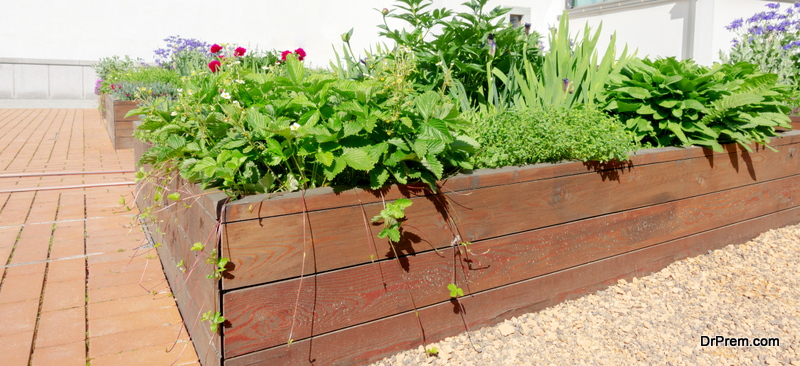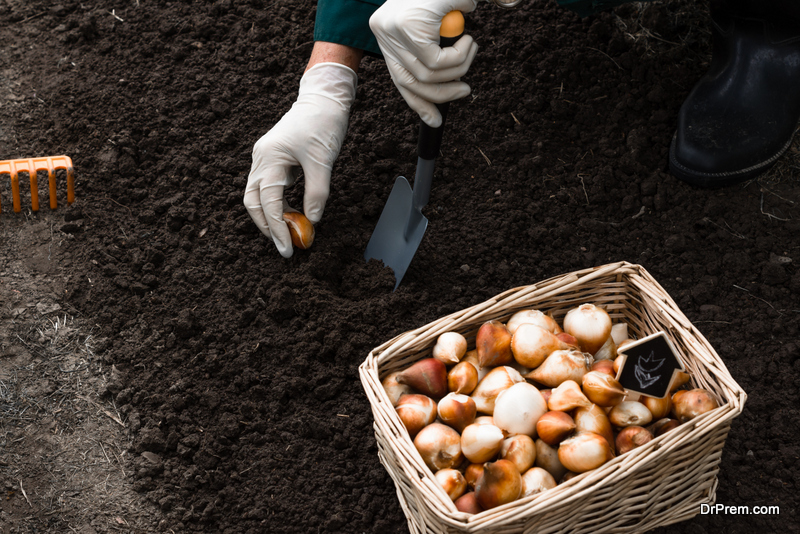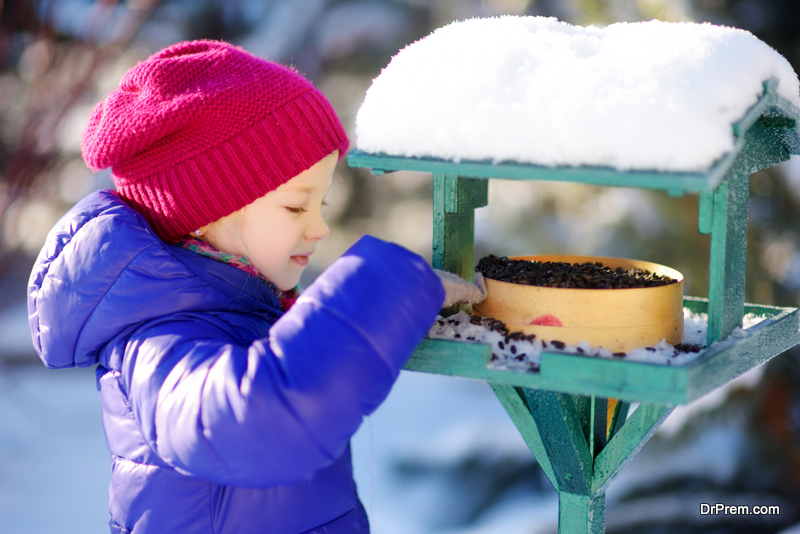Once the winter season rolls around, gardeners often find themselves bored, twiddling their thumbs with not much to do. However, an experienced gardener knows that winter is the ideal time to tackle otherwise neglected tasks and plan for the following year’s harvest.
Whether it’s taking care of rusty garden tools or the south-flying birds, there is actually plenty to do for a gardener to keep busy and occupied until spring. Here are 10 winter gardening tasks to prepare you for the next season.
1. Organize Your Nursery Workspace
 As you prepare your garden for the next season, bringing tools, containers, hoses and other such equipment indoors, organize a small nursery workspace inside a garage or outdoor shed. Hang items along a pegboard or hooks and keep an airtight drawer system for seeds and planter markers or other smaller items that tend to get misplaced in the shuffle. Build out shelves for large pots, planter boxes, plant fertilizer and other items. Keep heavier items like soil and mulch in a wheelbarrow on the ground. This way, you know precisely where everything is once the frost melts away and spring arrives.
As you prepare your garden for the next season, bringing tools, containers, hoses and other such equipment indoors, organize a small nursery workspace inside a garage or outdoor shed. Hang items along a pegboard or hooks and keep an airtight drawer system for seeds and planter markers or other smaller items that tend to get misplaced in the shuffle. Build out shelves for large pots, planter boxes, plant fertilizer and other items. Keep heavier items like soil and mulch in a wheelbarrow on the ground. This way, you know precisely where everything is once the frost melts away and spring arrives.
2. Add to Your Tool Collection
With your nursery and garden organized, consider purchasing additional garden tools. Take inventory of worn down tools that need replacing, especially if they have become a safety hazard, but also any that you may just want to make your gardening easier. While you’re cataloging your garden tools, clean them up and sharpen them. Give them an oil rub to keep sap and other dirt and grime from rusting blades and handles. Adding to your tool collection at the end of the gardening season means you can find better deals and discounts, too!
3. Order Seeds and Bulbs
 One winter gardening task that can prepare you for the next season is to ensure you have enough seeds and bulbs. Hopefully, you can have a clutter-free and organized nursery where you can easily locate your seed packets and bulb containers. Assess what you have on hand and order additional seeds or bulbs that might interest you for next year. You can visit a local nursery that grows native plants or purchase seeds from online growers.
One winter gardening task that can prepare you for the next season is to ensure you have enough seeds and bulbs. Hopefully, you can have a clutter-free and organized nursery where you can easily locate your seed packets and bulb containers. Assess what you have on hand and order additional seeds or bulbs that might interest you for next year. You can visit a local nursery that grows native plants or purchase seeds from online growers.
4. Start Composting
The winter months are a fantastic time to start a compost. Composting can do wonders for your garden, enriching it and allowing it to thrive, but it also offers an eco-friendly alternative that can save you money on potting soil year after year.
If you already have a compost going, assess the nutrients to find out what it may need to keep your garden healthy. Consider adding a worm farm or any other various types of composting.
5. Build or Repair Garden Beds and Cold Frames
 Before you have to plant or add a layer of mulch or ground covering, make any necessary repairs to the garden bed. If they’re pretty worn down or you want to try a new bed style, like a raised bed, start fresh. For example, raised beds are easy to build out and can even be purchased as complete kits you can readily assemble in one afternoon.
Before you have to plant or add a layer of mulch or ground covering, make any necessary repairs to the garden bed. If they’re pretty worn down or you want to try a new bed style, like a raised bed, start fresh. For example, raised beds are easy to build out and can even be purchased as complete kits you can readily assemble in one afternoon.
Besides repairing a garden bed, you could also build a cold frame. Cold frames are an excellent way to house and protect plants from severe winter weather and low freezing temperatures. Find an easy DIY cold frame plan and build it before the first frost. Many projects incorporate bricks and scrap wood with used objects like old furniture or repurposed glass windows. There are endless creative possibilities!
6. Check Stored Bulbs and Tubers
For bulbs and tubers, give them a quick check once a month. Make sure they’re healthy and that there is no excessive moisture or developing mold. If so, discard moldy roots and mist the bulbs and tubers that were near the affected root, returning them to storage once dry.
7. Protect with Mulch and Covers
 Before the winter season, make sure to tuck in your garden beds and less hardy trees and shrubs nice and cozy. Place a frost fleece or light blanket across garden beds to protect roots and delicate plants from freezing temps. You can also use a two-inch layer of mulch or leaves and straw for added insulation and extra protection. Winter mulching can even keep hardier veggies like lettuces and tubers warm so you can harvest well into the winter months.
Before the winter season, make sure to tuck in your garden beds and less hardy trees and shrubs nice and cozy. Place a frost fleece or light blanket across garden beds to protect roots and delicate plants from freezing temps. You can also use a two-inch layer of mulch or leaves and straw for added insulation and extra protection. Winter mulching can even keep hardier veggies like lettuces and tubers warm so you can harvest well into the winter months.
8. Propagate with Fresh Cuttings
During the winter season, you need to propagate plants. Even if you don’t plan on recreating an offspring in your garden, it’s a way to keep them healthy. Take some fresh cuttings of hardwoods or shrubs, rose bushes and berries, establishing them and giving them as holiday gifts.
9. Be Kind to the Birds
 Our avian friends have a tough winter. And without a garden that attracts insects and worms they survive on, it can be even tougher for birds to feed. So don’t leave birds hanging! Instead, add a garden feature to attract them. This bird-friendly feature can be anything from a bird feeder to a birdhouse. In warmer regions, a birdbath works nicely; however, in colder regions, freezing temps can harden water and crack the material. At the very least, you can purchase some affordable birdseed or place out some berries.
Our avian friends have a tough winter. And without a garden that attracts insects and worms they survive on, it can be even tougher for birds to feed. So don’t leave birds hanging! Instead, add a garden feature to attract them. This bird-friendly feature can be anything from a bird feeder to a birdhouse. In warmer regions, a birdbath works nicely; however, in colder regions, freezing temps can harden water and crack the material. At the very least, you can purchase some affordable birdseed or place out some berries.
10. Make a Game Plan for Spring
Look back on your year’s gardening and reflect on what was successful and areas that need improvement. Make notes that you might otherwise forget come spring and create a general plan for next year’s garden. Did a vegetable not work out? Determine why and decide on a remedy or if you’d prefer to try a different plant. Decide how the soil could be improved, too. You could even sketch a layout of the garden bed and designate certain areas for specific veggies or flowers you’d like to harvest. Essentially, make a game plan for spring.
Article Submitted By Community Writer




